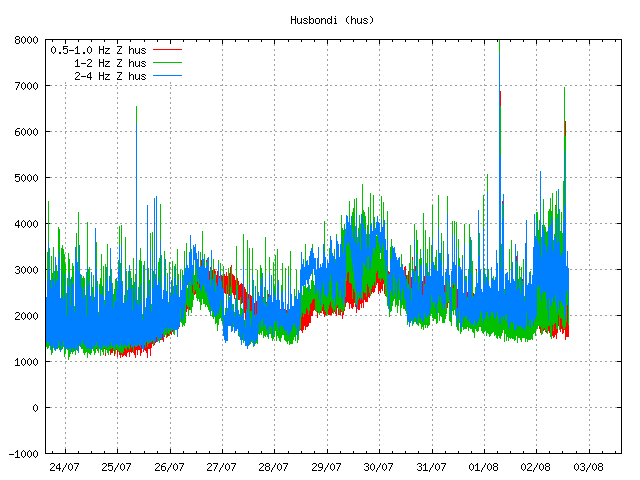It was confirmed today (02-August-2018) that glacier flood has started from Skaftárkatlar cauldron. According to the news the GPS monitoring station close the cauldrons started to drop around midnight. Around same time harmonic tremor started to change on nearby SIL stations.

Harmonic tremor on nearby SIL station due to glacier flood. Copyright of this image belongs to Icelandic Met Office.
It can take up to a week for the glacier flood to finish, but that depends on the amount of water in the cauldron that is emptying it self. According to the news the eastern Skaftákatlar cauldron is now emptying it self. It last did so three years ago.
Donations
Please remember to support my work with donations. It help me buying food and other stuff I need to write articles here. Thanks for the support. 🙂

Jon, you’ve attached a graph. Can you explain how to interpret it, as I don’t really know what its telling me? I’m sure others would appreciate it too
Anything before 02 line is noise. Spikes are earthquakes. The spike at 02 line is the glacier flood starting. Magma appears clearly if moving on 0.1 – 0.5Hz (red) band. But also on other bands as well when it moves. No movement on that band equals no magma movement normally. Sometimes noise can move the red band, but that is rare.
Are these readings accurate? That is quite a bit of water.
https://i.imgur.com/gLlXmtn.png
This glacier flood seems to be larger and faster moving than expected. I am not sure why that is at the moment. This was the latest news today on this glacier flood.
Sveinstindur is up at 1344.6m3/s at 19.30 this evening, impressive though still less than half of the 2015 glacier outburst discharge. Peak floood expected in 6-12 hours from now.
Both eastern and western Skaftárkatlar cauldron emptied them self this time around. It explains the odd behaviour of this glacier flood. Harmonic tremor pulses have been detected on nearby SIL stations confirming that both cauldrons are now empty of all water.